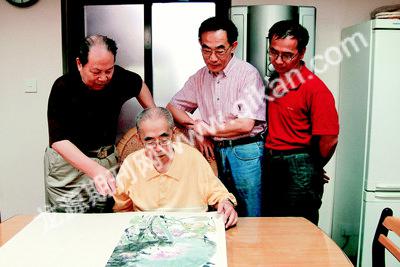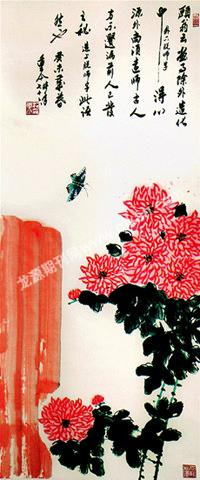A Scholar of Engraved Seals
2009-06-30PanGuojun
Pan Guojun

“A Collection of Forewords and Afterwords from Past Seal Books” has been released in celebration of the 105th anniversary of the Hangzhou-based Xinling Seal Engravers Association. This valuable collection was put together and edited by Yu Zhongjin over a period of several decades.
When he came to Hangzhou, where the headquarters of the most renowned association of seal engravers in China is based, Yu Zhongjin had nothing to do with the association or its precious seals or seal masters. He came to Hangzhou from Shanghai to join his wife Zhang Qinjuan. She had come to Hangzhou because she, an excellent Yueju Opera star, was invited to star in Yueju plays in the city and later became the director of Hangzhou Yueju Opera Troupe in 1956. The husband followed the wife to Hangzhou and settled down. Yu first worked as an accountant in an art company under the Hangzhou Bureau of Culture. And in 1963, Yu Zhongjin began working at the Xinling Seal Engravers Association and became a disciple to Han Dengan, the secretary-general of the organization.
This job inducted Yu Zhongjin into a big and amazing world of Chinese calligraphy and seal engraving and started him onto a long journey toward putting together the collection decades later.
Xiling has Chinas biggest collections of books of seal prints by masters over centuries. The most precious part is a collection of 433 titles in 1,931 volumes donated by Zhang Luan (1901-1962), a member of the association and the owner of Zhang Tongtai, a leading TCM pharmacy in Hangzhou. His collection contains many a prime book of seals by ancient masters of the Ming (1368-1644) and the Qing (1644-1911) dynasties. For example, Master Gus Collection of Seals was published in 1572 and only 20 copies were printed. Today, only one collector in the world has all the six volumes of the book. Zhang Luan had 4 volumes, rated as the state grade-one historical and cultural heritage. Also in Zhang Luans collection is a book of seals printed by Chen Jieqi (1813-1884), a collector of the Qing Dynasty. He printed only one big-format copy and gave it away as a very precious gift to Wu Dacheng. Years later Shanghai-based artist Wu Hufan acquired this book. Zhang Luan bought it from Wu for 800 silver dollars, a big fortune at that time. When Zhang passed away, his family donated the whole colossal collection to Xiling.
The year 1964 witnessed the celebrations of the 60th anniversary of the association and Yu was instructed by his master Han Dengan to take part in the preparations of 3,000 seal prints for publication. While Yu did his work at the library of the association, Chai Ziying, a scholar of seals who came all the way from Shanghai to sort out the donated collection of Zhang Luan, was also working at the same library. As the two saw each other every day and worked together, the knowledgeable Chai chatted about the collection he was going through and Yu, a diligent and smart disciple, listened and took notes. Yu later worked out a transcript of the mini lectures on the basis of the notes. Chai edited the manuscript and Yu made two copies, one for Chai and one for himself.

In 1978 Yu Zhongjin became an editor at the newly established Xinling Press. He wrote a column for a periodical for seal enthusiasts published by the press. On the basis of Master Chais mini lectures, he wrote brief introductions to some ancient seal collections. Readers responded warmly to the articles. Yu wondered how much more readers of today would be helped if all the forewords and afterwords in ancient collections of seal books could be compiled into one book. By then his mentor Han Dengan had passed away. So Yu Zhongjin went to Shanghai and talked with Master Chai Ziying. Chai thought it was a good idea and encouraged Yu to continue to write introductions and asked him to copy forewords and afterwords from originals so that he could read them later. Together, they formulated a list of 150 seal books whose forewords and/or afterwords were important.
But the project was put on the burner when Yu Zhongjin retired and engaged in art business in Shenzhen. Chai passed away. In 2003 when Xiling was preparing to celebrate its 100th anniversary, Yu and his friends met and talked about the proposed collection of forewords and afterwords. All his friends thought it was a good idea and encouraged him to resume and complete the project.
So Yu Zhongjin started again. These writings are important because they are mostly about theories and tips on calligraphy and seal engraving and because they provide historical insight into evolutions and styles of seal engraving as well as collections. He studied these writings, wrote annotations and explanations, and produced editorial and artistic facts on first editions such as size, compilation year, printers introduction, the number of copies at one impression. He also added punctuations to the ancient writings that were originally written without using a punctuation system. In order to make punctuations and annotations accurate, Yu Zhongjin consulted experts extensively. Altogether he selected and edited 522 forewords and afterwords from 142 seal books.
This collection was released in October, 2008.□
